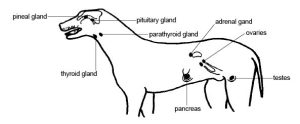Dogs who suffer from Cushing’s disease possess an issue with their adrenal glands, two organs that are situated in front of each kidney. As the disease progresses, the most distinctive sign is frequent urination combined with an excessive thirst. Additionally, dogs suffer from muscle atrophy and thinning of their skin, as well as hair loss on their neck and in the perineal area -near the genitals and rectum. You may observe signs of increased hunger and abdominal distension in dogs that are prone to Cushing’s disease. Adult dogs of 8 years or older, particularly breeds such as Beagles, Dachshunds, German Shepherds and Yorkshire Terriers are more likely to suffer from Cushing’s Disease.

If your dog is suspected to have the disease, it may be difficult for a veterinarian to diagnose and more complex tests may need to be done. A stimulation test is usually the next step for a veterinarian if they observe something abnormal in blood and urine tests. Your veterinarian will take a blood sample from your dog to check the cortisol levels and administer an injection of Adreno corticotropin hormone for this test. Your vet will take another blood sample from your pooch a few hours later to retest the cortisol level if Cushing’s disease is suspected. To help your veterinarian discover the cause of Cushing’s disease, other tests such as ultrasound can be used which will then decide on the appropriate treatment. In the majority of cases, dogs suffering from this ailment have a non-malignant growth on their pituitary gland which is minimal in size and does not typically metastasize; hence, it does not lead to any physical complications. If an adrenal tumor is the cause of pituitary dependent disease, most dogs are typically treated with medication. Your vet may suggest further testing to determine if the tumor is cancerous or not. If it turns out to be malignant, they may recommend surgery to remove the adrenal tumor. On average, a dog diagnosed with Cushing’s disease has an expected survival rate of two years; however, it does not necessarily result in death. In many cases, by the time Cushing’s disease is identified, the canine is already in its geriatric stage.
 wagwagtail "only love can make your dog wag her tail"
wagwagtail "only love can make your dog wag her tail"
